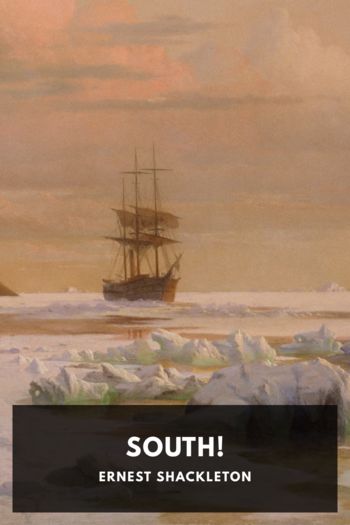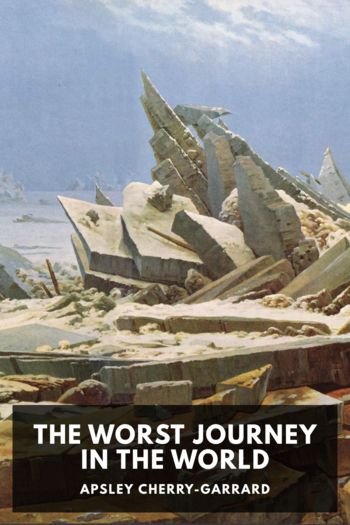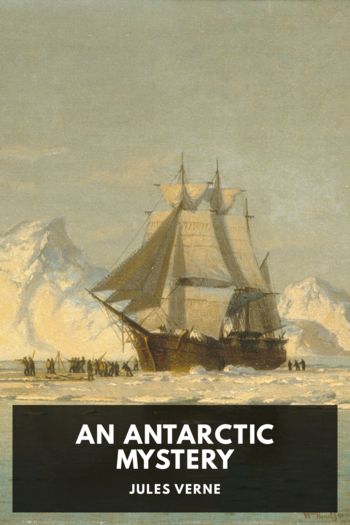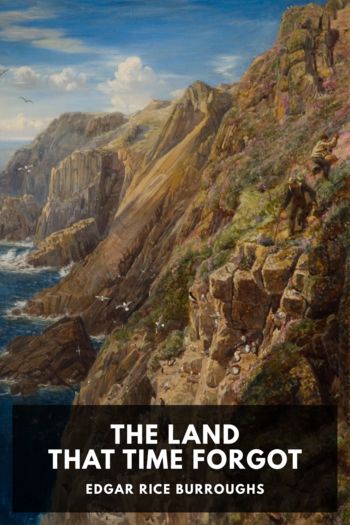South!, Ernest Shackleton [good books to read in english TXT] 📗

- Author: Ernest Shackleton
Book online «South!, Ernest Shackleton [good books to read in english TXT] 📗». Author Ernest Shackleton
“May 21.—Early this morning there appeared to be movements in the ice. The grating and grinding noise makes one feel the unimportance of man in circumstances like ours. Twilight towards noon showed several narrow, open leads about two cables from ship and in all directions. Unable to get bearing, but imagine that there is little or no alteration in ship’s position, as ship’s head is same, and Western Mountains appear the same. … Hope all is well at Cape Evans and that the other parties have returned safely. Wish we could relieve their anxiety.
“May 22.—Obtained good bearings of Beaufort Island, Cape Ross, and Dunlop Island, which put the ship in a position eighteen miles south 75° east (true) from Cape Ross. Since the 14th, when reliable bearings were last obtained, we have drifted northwest by north seven miles.
“May 24.—Blizzard from south-southeast continued until 9 p.m., when it moderated, and at 11:45 p.m. wind shifted to northwest, light, with snow. Quite a lot of havoc has been caused during this blow, and the ship has made much northing. In the morning the crack south of the ship opened to about three feet. At 2 p.m. felt heavy shock and the ship heeled to port about 70°. Found ice had cracked from port gangway to northwest, and parted from ship from gangway along to stern. Crack extended from stern to southeast. 7:35 p.m.—Ice cracked from port fore chains, in line parallel to previous crack. The ice broke again between the cracks and drifted to northwest for about ten yards. The ice to southward then commenced to break up, causing heavy strain on ship, and setting apparently north in large broken fields. Ship badly jammed in. 9:15 p.m.—Ice closed in again around ship. Two heavy windsqualls with a short interval between followed by cessation of wind. We are in a labyrinth of large rectangular floes (some with their points pressing heavily against ship) and high pressure-ridges.
“May 25.—In middle watch felt pressure occasionally. Twilight showed a scene of chaos all around; one floe about three feet in thickness had upended, driven under ship on port quarter. As far as can be seen there are heavy blocks of ice screwed up on end, and the scene is like a graveyard. I think swell must have come up under ice from seaward (northeast), McMurdo Sound, and broken the ice, which afterwards started to move under the influence of the blizzard. Hardly think swell came from the Sound, as the cracks were wending from northwest to southeast, and also as the Sound should be getting icebound by now. If swell came from northeast then there is open water not far away. I should like to know. I believe the Ross Sea is rarely entirely ice-covered. Have bright moonlight now, which accentuates everything—the beauty and loneliness of our surroundings, and uselessness of ourselves, while in this prison: so near to Cape Evans and yet we might as well be anywhere as here. Have made our sledging-ration scales, and crew are busy making harness and getting sledging equipment ready for emergencies. Temperature −30° F.
“May 26.—If the ship is nipped in the ice, the ship’s company (eighteen hands) will take to four sledges with one month’s rations and make for nearest land. Six men and one sledge will endeavour to make Cape Evans via the western land, Butler Point, Hut Point, etc. The remaining twelve will come along with all possible speed, but no forced marches, killing and depot-ing penguins and seals for emergency retreats. If the ship remains here and makes no further drift to the north, towards latter end of July light will be making. The sun returns August 23. The sea-ice should be fairly safe, and a party of three, with one month’s rations, will proceed to Cape Evans. If the ice sets north and takes the ship clear of land, we will proceed to New Zealand, bunker, get extra officer and four volunteers, provisions, etc., push south with all speed to the Barrier, put party on to the Barrier, about two miles east of Cape Crozier, and land all necessary stores and requirements. The ship will stand off until able to reach Cape Evans. If necessary, party will depot all stores possible at Corner Camp and go on to Cape Evans. If worst has happened my party will lay out the depot at the Beardmore for Shackleton. If the ship is released from the ice after September we must endeavour to reach Cape Evans before going north to bunker. We have not enough coal to hang about the Sound for many days.
“May 28.—By the position obtained by meridian altitude of stars and bearing of Mount Melbourne, we have drifted thirty-six miles northeast from last bearings taken on 23rd inst. The most of this must have been during the blizzard of the 24th. Mount Melbourne is one hundred and eleven miles due north of us, and there is some doubt in my mind as to whether the peak which we can see is this mountain. There may be a mirage. … In the evening had the football out on the ice by the light of a beautiful moon. The exercise and break from routine are a splendid tonic. Ice-noises sent all hands on board.
“June 1.—Thick, hazy weather. In the afternoon a black streak appeared in the ice about a cable’s length to the westward and stretching north and south. 8 p.m.—The black line widened and showed long lane of open water. Apparently we are fast in a floe which has broken from the main field. With thick weather we are uncertain of





Comments (0)